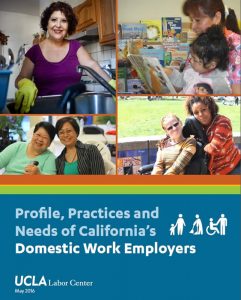Profile, Practices and Needs of California’s Domestic Work Employers
Saba Waheed, Lucero Herrera, Reyna Orellana, Blake Valenta and Tia Koonse
May 16, 2016
Economic Justice, Labor and Occupational Safety, Publications, ReportSummary
Domestic work is an indispensable part of American life. Domestic workers support families and individuals with pressing childcare, homecare and housecleaning needs and for seniors and those with illnesses or disabilities, domestic workers enable independence and the possibility of living in their own homes. Profile, Practices and Needs of California’s Domestic Work Employers, the first comprehensive study of domestic work employers, closely examines those who hire for housecleaning, childcare, and homecare services. Based on 501 randomly-dialed phone surveys throughout the state, this study provides demographic and household details, as well as an understanding of the employment practices and needs of domestic employers. 1. Californians rely on domestic work. Employers have diverse needs for domestic work and a nuanced demographic profile. a. There are two million domestic employers in California who hire for housecleaning (54%), homecare support (27%), and childcare (19%). b. 10% of employers hire live-in workers, and 6% require 24-hour care. c. The demographic profile of employers is broad: over half identify as white, but 43% are Latino, African American, Asian American, and mixed or other races E d. One-quarter of employers are in professional and managerial jobs and almost one-quarter work in “frontline” jobs such as in offices, service work, construction, domestic work, etc. One-third of employers are retired. e. More than half (56%) of employer households are in moderate or higher income brackets, while 44% are in low-income households. 2. Employment practices are individualized, and work schedules and payment arrangements vary widely. The domestic work industry lacks the structures common to other workplaces, and employment practices can become individualized. The absence of regular and predictable practices leads to wide variations in work and pay arrangements. a. Almost three-quarters (71%) of employers use personal networks, such as friends, colleagues, family members, or neighbors to find workers. b. When employers need to set specific conditions for hours, pay, and benefits with the worker, half (49%) report that they did not do research or seek advice—they simply devised the terms themselves. c. About half of employers (54%) require a worker for a few hours a month, seasonally or on-call, while a third hire workers weekly for up to 30 hours. Very few employers hire for full-time work. d. Less than one-quarter pay an hourly rate. Half (56%) pay a flat rate per day and 18% pay a weekly or monthly rate. When an hourly rate is calculated, the wage demonstrably fluctuates, and can be as low as a few dollars an hour or as high as $40-$50 e. Most employers (83%) pay workers the minimum wage, but low wages are nonetheless prevalent in the industry. Four in ten employers pay low wages, defined as two-thirds of the median full-time wage in California. On the other hand, one-third of employers pay above a self-sufficiency wage, which calculates the costs of basic needs for California’s working families who do not rely on public or private assistance. 3. Employers value domestic work and need more support. Many employers both need more support and would prefer to pay more. Strategies to address this need must balance support for employers with sustainable wages and working conditions for workers, and will require public investment in families and individuals. a. One-third, mostly homecare and childcare employers, would pay better wages. b. In addition, 41% said that they need more hours of support. c. It is especially difficult for homecare and childcare employers to receive the domestic support they need, and they require public investment. d. Three-quarters of childcare employers are low income, and hire from their own community. e. Over half (53%) of homecare employers receive some form of government funding, but 14% pay some of their workers’ wages out-of-pocket.


